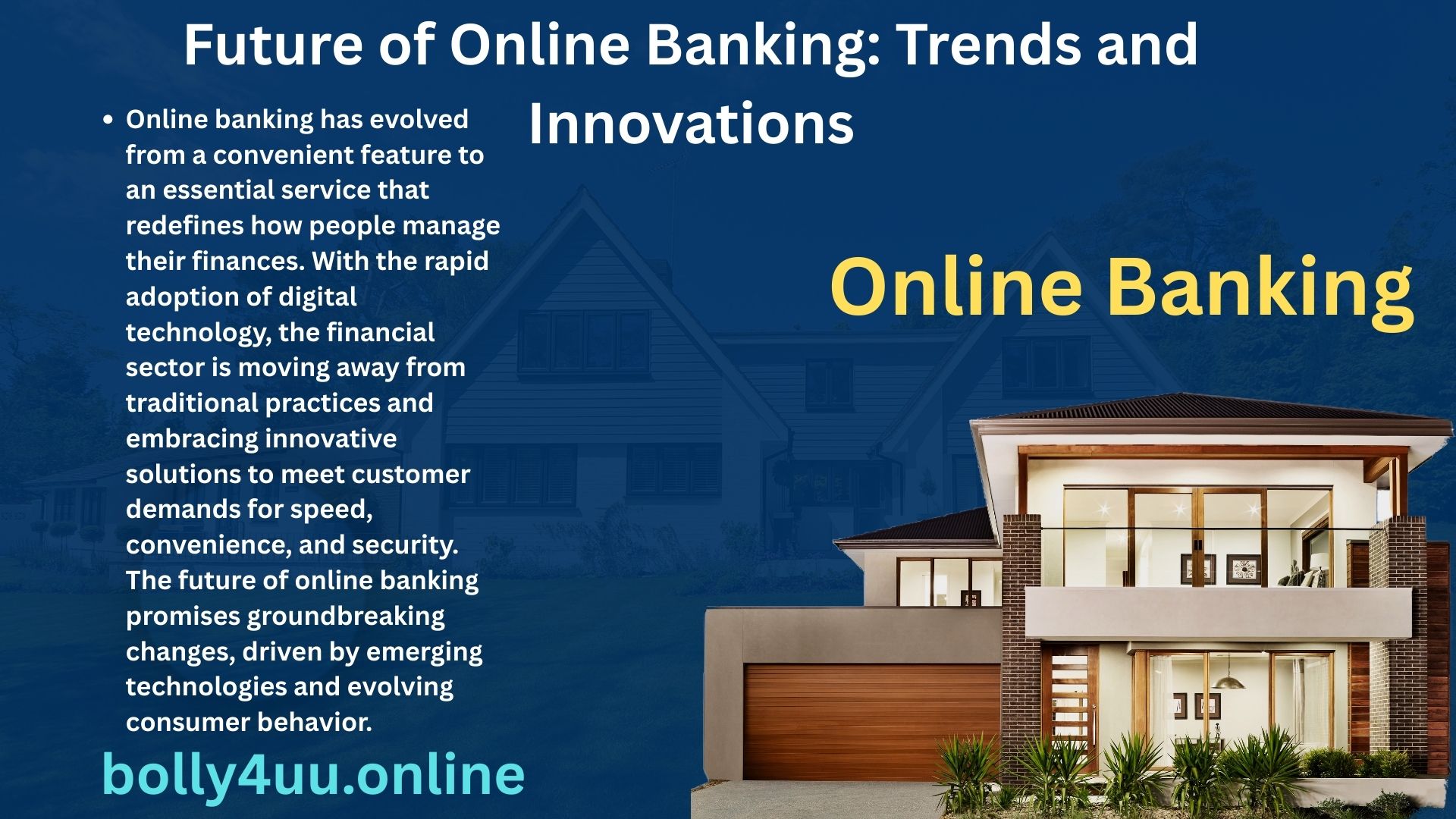Introduction
Online banking has evolved from a convenient feature to an essential service that redefines how people manage their finances. With the rapid adoption of digital technology, the financial sector is moving away from traditional practices and embracing innovative solutions to meet customer demands for speed, convenience, and security. The future of online banking promises groundbreaking changes, driven by emerging technologies and evolving consumer behavior.
This article explores the future trends, key innovations, benefits, challenges, and predictions that will shape online banking in the coming years.
Why Online Banking is the Future of Finance
The future of finance is undeniably digital-first. The rise of online banking has been fueled by several factors:
- Convenience: Customers can manage accounts anytime, anywhere.
- Cost Efficiency: Banks save operational costs by reducing physical branches.
- Global Connectivity: Increased internet penetration and smartphone usage.
- Security Improvements: Advanced authentication methods reduce fraud risks.
Top Trends Shaping the Future of Online Banking
1. Artificial Intelligence (AI) and Machine Learning
AI and Machine Learning are revolutionizing the banking industry by delivering personalized, predictive, and secure experiences.
Key Applications of AI in Banking:
- AI-Powered Chatbots: Providing 24/7 customer support.
- Fraud Detection: Identifying suspicious transactions in real-time.
- Personalized Recommendations: Offering tailored financial products.
2. Blockchain and Distributed Ledger Technology
Blockchain offers transparency, immutability, and security in banking transactions.
Benefits of Blockchain in Banking:
- Faster Cross-Border Payments with reduced costs.
- Smart Contracts for automated, trustless agreements.
- Decentralized Finance (DeFi) allowing peer-to-peer transactions without intermediaries.
3. Rise of Neobanks (Digital-Only Banks)
Neobanks operate entirely online without physical branches, offering:
- Low or zero fees on services.
- User-friendly apps with innovative features.
- Instant account creation with virtual cards.
4. Biometric Authentication
To enhance security, banks are replacing passwords with biometric authentication methods:
- Fingerprint Scanning
- Facial Recognition
- Voice Authentication
Advantages:
- Eliminates password-related risks.
- Provides faster and more secure access.
5. Open Banking and API Ecosystems
Open banking uses APIs to allow third-party financial service providers to access consumer data (with consent) to develop innovative products.
Benefits of Open Banking:
- Better financial product comparisons.
- Enhanced customer experience through third-party apps.
- Greater competition leading to improved services.
6. Voice-Activated Banking
Voice technology is enabling hands-free banking experiences.
Examples of Voice Banking Features:
- Checking account balances.
- Transferring money via voice commands.
- Paying bills through voice assistants like Alexa or Google Assistant.
7. Cloud-Based Banking Solutions
Banks are adopting cloud technology to improve efficiency and scalability.
Advantages of Cloud Banking:
- Cost Reduction by eliminating expensive hardware.
- Enhanced Data Security with advanced encryption.
- Faster Updates for banking applications.
8. Contactless and Digital Payments
The future of transactions lies in contactless payment methods and digital wallets.
Popular Technologies:
- NFC-enabled payments.
- QR code scanning.
- Wearable payment devices like smartwatches.
9. Hyper-Personalization Using Big Data
Banks are leveraging big data and analytics to create personalized experiences for customers.
Examples:
- Custom investment advice.
- Real-time spending alerts.
- Tailored credit and loan offers.
10. Sustainable and Green Banking
With increasing environmental awareness, banks are adopting eco-friendly practices:
- Paperless statements.
- Digital transactions instead of checks.
- Promoting green investment funds.
Benefits of Future Online Banking Innovations
| Feature | Benefit to Customers |
|---|---|
| AI-Powered Chatbots | Instant customer support |
| Blockchain Technology | Secure and transparent transactions |
| Biometric Authentication | Improved security and ease of access |
| Open Banking APIs | Better financial product comparisons |
| Voice Banking | Hands-free, convenient banking |
Challenges in the Future of Online Banking
Despite numerous advantages, there are challenges that banks must overcome:
- Cybersecurity Threats: Increasing sophistication of hackers.
- Regulatory Compliance: Adhering to evolving legal frameworks.
- Digital Literacy: Educating customers about safe banking practices.
- Technology Integration: Migrating from legacy systems to modern platforms.
How Banks Are Preparing for the Future
Financial institutions are investing heavily in technology and partnerships to ensure future readiness.
Key Steps Banks Are Taking:
- Implementing AI-driven security protocols.
- Building API-based ecosystems.
- Enhancing mobile banking apps with innovative features.
- Collaborating with fintech companies for advanced solutions.
Predictions for Online Banking in the Next Decade
- 100% Digital Banking: Physical branches will become rare.
- AI Financial Advisors: Personalized wealth management powered by AI.
- Virtual Reality (VR) Banking: Immersive banking experiences in VR environments.
- Instant Global Payments: Blockchain-powered real-time transfers.
- Integration of Digital Currencies: Cryptocurrencies as part of mainstream banking.
Best Practices for Secure Online Banking
Even as technology improves security, users must adopt safe banking habits:
- Enable Two-Factor Authentication (2FA).
- Avoid using public Wi-Fi for transactions.
- Regularly monitor bank statements.
- Update banking apps and devices frequently.
- Use strong and unique passwords.
Frequently Asked Questions (FAQs)
1. Will traditional banks disappear in the future?
Not entirely, but physical branches will reduce significantly as digital banking dominates.
2. Is online banking safe with advanced technologies like AI and blockchain?
Yes, these technologies make online banking more secure than ever before.
3. What are Neobanks?
Neobanks are digital-only banks offering services without any physical branches.
4. How does biometric authentication help in banking security?
Biometrics such as fingerprints and facial recognition reduce risks of identity theft and unauthorized access.
5. What role will cryptocurrencies play in online banking?
Cryptocurrencies and blockchain will enable faster, cheaper, and more secure cross-border payments.
Conclusion
The future of online banking is driven by technology, convenience, and personalization. Innovations like AI, blockchain, biometrics, open banking, and cloud technology will revolutionize financial services, making them faster, safer, and more customer-centric. While challenges such as cybersecurity and regulatory compliance remain, the benefits far outweigh the risks.
As digital banking continues to evolve, customers must stay informed, adopt safe banking practices, and embrace the new technologies shaping the financial landscape.
